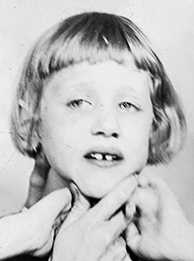Search for Names, Places and Biographies
Already layed Stumbling Stones
Suche
Irmgard Hrabe * 1930
Conventstraße 27 (Wandsbek, Eilbek)
HIER WOHNTE
IRMGARD HRABE
JG. 1930
EINGEWIESEN 1943
"HEILANSTALT" EICHBERG
ERMORDET 24.9.1943
further stumbling stones in Conventstraße 27:
Emilie Mayer, Ernst Mayer
Irmgard Hrabe, born on 3 Dec. 1930 in Hamburg, murdered on 24 Sept. 1943 in the Heil- und Pflegeanstalt Eichberg
Hasselbrookstrasse 11
Irmgard Hrabe was born in Hamburg-Eilbek as the youngest of five children of the married couple Lina, née Sjöberg, born on 26 Apr. 1898, and the warehouse foreman Waldemar Hrabe, born on 15 Apr. 1896 in Hamburg-Hamm, and baptized in the local Friedenskirche (peace church) on 31 May 1931. Her aunt Luise Sjöberg took on the role of godmother. Her mother, Lina Sjöberg, came from a Protestant, her father, Waldemar Hrabe, from a Catholic family with Czech roots. His father in turn, the typesetter Peter Friedrich Hrabe, was married to Katharina, née Liewald.
Both parents had many siblings and both completed attending the eight-grade elementary school (Volksschule). Waldemar Hrabe fought in World War I and returned with injuries. The couple got married in Apr. 1923 in Oldendorf/District of Melle, Lina’s native town. The years 1924, 1926, and 1928 each saw the birth of a son, 1929 the birth of the first daughter, followed one and a half years later by daughter Irmgard. The brothers attended the eight-grade elementary school for boys on Ritterstrasse, the sisters the eight-grade elementary school for girls on Hasselbrookstrasse, completing their schooling successfully. At age 14, the oldest brother started training to become a plumber.
Irmgard Hrabe began to walk at the age of three. Until then, her mother had not noticed anything special about her. The girl was easily excited but sociable. When aged four, Irmgard began to speak, and her behavior changed. She was now constantly on the move and at the same time so unpredictable that she required constant supervision in order not to endanger her siblings. She never attended school and was placed in what was then the Alsterdorf Asylum (Alsterdorfer Anstalten). When she was admitted, a family tree was compiled towards determining "hereditary health” and transmitted to the "Race Office” ("Rassenamt”). It is not known what emerged from it.
Irmgard put up resistance against any physical contact, though she did occupy herself with the balls and toy cars offered. During the following years, she did not establish any recognizable relationship with her environment and repeatedly suffered from serious infectious diseases. Her family fetched her home on institutional leave as often as possible.
The only way to alleviate Irmgard’s restlessness was to administer medications. In addition, she wore a "protective jacket” (Schutzjacke), because otherwise she would tear everything apart. Probably her unruliness was the reason why she was assigned to the first transport of male and female patients put together on 7 Aug. 1943 aimed at relieving the then Alsterdorf Asylum. Overall, the transport included 128 children and men from Alsterdorf and 82 men from the Langenhorn "sanatorium and nursing home” (Heil- und Pflegeanstalt Langenhorn). They were distributed to the Kalmenhof/Idstein and Eichberg institutions. The 28 children, in part transported lying on top of each other wearing their "protective jackets,” were taken to the "Heil- und Pflegeanstalt Eichberg,” a "sanatorium and nursing home,” 20 of them to the "children’s special ward” ("Kinderfachabteilung”), the remainder to the women’s ward. Soon after their arrival and without having undergone the procedures associated with the "Reich Committee” ["for the Scientific Registering of Serious Hereditary and Congenital Illnesses”] ("Reichsausschuss” ["zur wissenschaftlichen Erfassung von erb- und anlagebedingten schweren Leiden”]), the first group was murdered (see publication on Stolpersteine im Stadtteil Hamburg-Rothenburgsort). The remaining eight suffered the same fate after their transfer to the "children’s special ward” within the next two months, with the exception of a five-year-old girl. Irmgard Hrabe died on 24 Sept. 1943, allegedly of circulatory weakness due to pneumonia in conjunction with "idiocy” ("Idiotie”) – certain clues to her murder. She died at the age of 12, and her death was duly registered at the Eltville/Rheingau records office.
Translator: Erwin Fink
Kindly supported by the Hermann Reemtsma Stiftung, Hamburg.
Stand: October 2016
© Hildegard Thevs
Quellen: Ev. Stiftung Alsterdorf, Archiv, V 27; StaH 332-5 Standesämter 2409-719/1896, 7340-560/1956, 8468-164/1966; Stadtarchiv Eltville, Sterberegister 1943.


